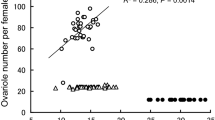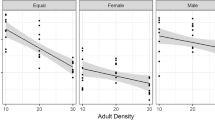Abstract
We test the adaptive value of clutch size observed in a natural population of the chestnut weevil Curculio elephas. Clutch size is defined as the number of immatures per infested chestnut. In natural conditions, clutch size averages 1.7 eggs. By manipulating clutch size in the field, we demonstrate that deviations from the theoretical ”Lack clutch size”, estimated as eight immatures, are mainly due to proximate and delayed effects of clutch size on offspring performance. We show the existence of a trade-off between clutch size and larval weight. The latter, a key life-history trait, is highly correlated with fitness because it is a strong determinant of larval survival and potential fecundity of offspring females. The fitness of different potential oviposition strategies characterized by their clutch sizes, ranging from one to nine immatures, was calculated from field- estimated parameters. Chestnut weevil females obtain an evolutionary advantage by laying their eggs singly, since, for instance, fitness of single-egg clutches exceeds fitness of two-egg clutches and four-egg clutches by 8.0% and 15.1% respectively.
Similar content being viewed by others

Author information
Authors and Affiliations
Additional information
Received 4 August 1999 / Accepted: 7 October 1999
Rights and permissions
About this article
Cite this article
Desouhant, E., Debouzie, D., Ploye, H. et al. Clutch size manipulations in the chestnut weevil, Curculio elephas: fitness of oviposition strategies. Oecologia 122, 493–499 (2000). https://doi.org/10.1007/s004420050971
Issue Date:
DOI: https://doi.org/10.1007/s004420050971



